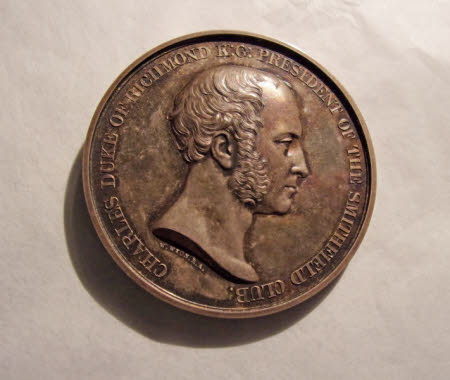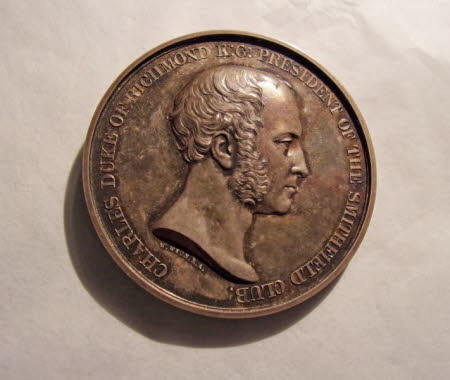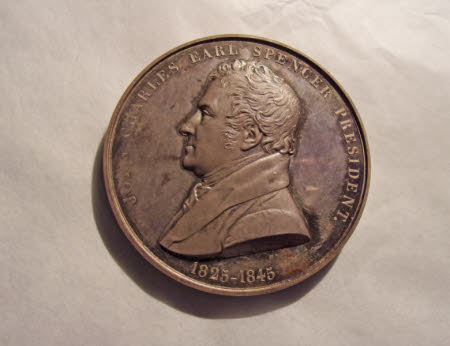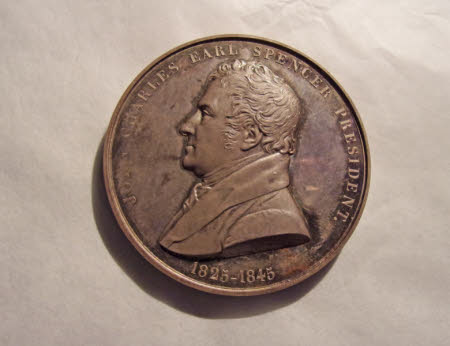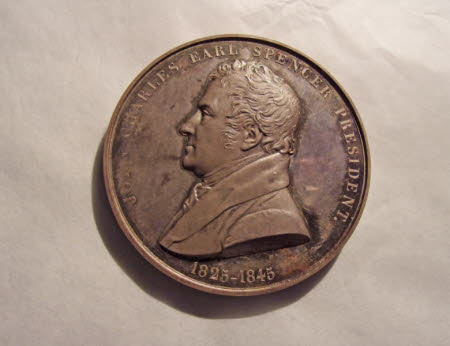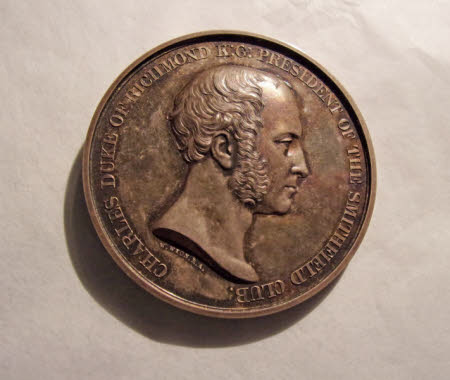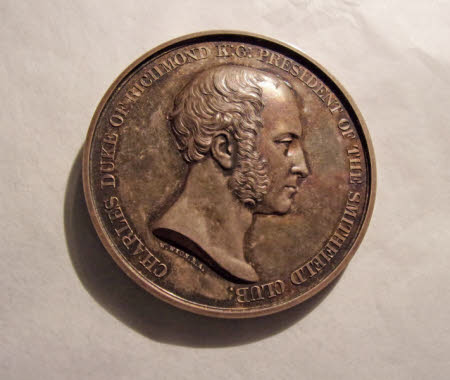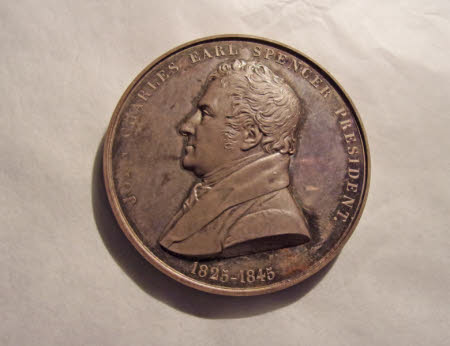Lord Bristol’s Smithfield Club Prize Medals
William Wyon (1795 - 1851)
Category
Coins and medals
Date
1850 - 1851
Materials
Silver
Measurements
4 mm (Height); 47 mm (Diameter)
Place of origin
London
Order this imageCollection
Ickworth, Suffolk
NT 849222
Summary
Sculpture, silver; Lord Bristol’s Smithfield Club Prize Medals, by William Wyon (1795-1851); London, c. 1850-51; these casts c. 1880-1887. Four examples in silver of the Smithfield Club Prize Medal, by William Wyon (1795-1851), awarded for improvements in the breeding of cattle. The obverse of the medal has a bust portrait facing left of John Charles Spencer, Viscount Althorp and Third Earl Spencer (1782-1845), President of the Smithfield Club, whilst on the reverse is a bust portrait facing right of Charles Gordon Lennox, fifth Duke of Richmond (1791-1860), Vice-President of the Club until 1845, when he succeeded Earl Spencer as President.
Full description
Four examples in silver of the Smithfield Club medal (NT 849222.1-4). The obverse of the medal has a draped bust of Earl Spencer, in contemporary dress and in profile, facing left. The legend: JOHN CHARLES EARL SPENCER. 1825-1845 and, below the truncation of the bust, the artist's signature: W. WYON, R.A. The reverse is the bust of the Duke of Richmond, facing right and bare-shouldered. The legend: CHARLES DUKE OF RICHMOND K: G: PRESIDENT OF THE SMITHFIELD CLUB and, below the truncation of the bust, the artist's signature: W. WYON, R.A. Each of the four medals has an engraved inscription on its edge referring to the Earl of Bristol's prize for the particular year’s show. The Smithfield Club, today’s Royal Smithfield Club, was instituted as the Smithfield Cattle & Sheep Society in 1798 and founded as the Smithfield Club in 1802. The Club’s aims, as explained on its present-day website, are ‘working for the benefit of the public promoting best practice in the production of quality livestock for the British meat industry to improve and promote the breeding of cattle, sheep, pigs, poultry and other livestock.’ The Club was responsible for the establishment of the Royal Agricultural Society in 1838. The Club’s President between 1825 and 1845 was John Spencer, 3rd Earl Spencer (1782-1845), a passionate agriculturalist who during his presidency restored the financial fortunes of the Smithfield Club. After his death in 1845. Lord Spencer’s successor as President was Charles Gordon-Lennox, 5th Duke of Richmond (1791-1860), who was especially noted for the improvements he effected in the breeding of Southdown cattle. From 1862 the shows were held at the newly built Royal Agricultural Hall in Islington. This version of the Smithfield Club medal, incorporating portraits of the Club’s two most recent presidents, came about as a result of a decision taken at the Club meeting held on 10th December 1850, at which it was agreed to ask William Wyon to prepare a portrait of the Duke of Richmond for the medal (Powell 1902, p. 10). The new medal followed two earlier versions, both of which had largely blank reverses to allow the engraving of the names and achievements of prize winners. The first, from 1814, featured the portrait of the Club’s second President John Russell, 6th Duke of Bedford (Jones 2025, no. 19). There is a version in gold of this rare medal at Belton House (NT 437376). The Club’s second medal, created in 1841/42, has the same portrait of Earl Spencer as the later medal, combined with a largely blank reverse (Jones 2025, no. 172). It may be that the intention with the third medal was to create one with the Duke of Richmond on the obverse and a blank reverse, but that the death of William Wyon meant that his design for the reverse was never completed. In any event, the decision to have portraits on both sides of the new third medal meant that prize-winners’ inscriptions had to be engraved on the rims of the medals. All three of these medals were designed by William Wyon (1795-1851, the best-known member of the Wyon dynasty of engravers and die-makers. Originally from Germany, the Wyon family was by the eighteenth century established in Birmingham, where William Wyon spent his early years. Already by 1811 his talents as an engraver had been noted by the celebrated gem engraver Nathaniel Marchant, who advised that the young man could have greater opportunities to practise his art in London. The 1814 Smithfield Club medal with the portrait of the Duke of Bedford was one of his earliest works. In 1816 Wyon moved to London, where he studied at the Royal Academy and was appointed assistant die-engraver at the Royal Mint. In 1828 he was appointed chief engraver, in which post he remained for the remainder of his life. It has recently been stated that ‘More people have seen William Wyon’s work than that of any other British artist’ (Jones 2025, p. 5), thanks to his prodigious and broad output which included designs for coinage, portrait medals and postage stamps. Wyon was responsible for designing effigies for the coinage of several monarchs, George IV, William IV and the so-called ‘Young Head’ of Queen Victoria, in use on coins from 1838 to 1860. His ‘City Medal’ of Victoria, struck in 1837, was the model for the head of the queen on line-engraved postage stamps issued between 1840 and 1879, beginning with the celebrated Penny Black. A neo-classicist, who greatly admired the work of John Flaxman (1755-1826), William Wyon was responsible for the design of some of the finest medals made in nineteenth-century Britain, and was also a superb portraitist, as can be seen from the Smithfield Club medal. The medals were awarded as prizes by the Smithfield Club over many years, with the details of the winner and the prize being engraved on the edge. The inscriptions on the four examples of the medal at Ickworth all record prizes awarded to Frederick William Hervey, 3rd Marquess of Bristol (1834-1907) for his Suffolk sheep at the shows in 1880, 1883, 1884 and 1885. Lord Bristol was a keen exhibitor at the Club’s shows and other agricultural shows over several years. Unlike other members of the aristocracy, he does not though seem to have taken an active part in the business of the Club, as President, Vice-President or Trustee. In an article in 1885 in the Bury and Norwich Post (‘The Suffolk Sheep’, 25 August 1885), the 3rd Marquess is noted as an enthusiastic supporter of the Suffolk breed: ‘Many of our landowners have freely patronised Suffolk sheep. The Marquis of Bristol especially has taken great interest in them. His Lordship’s ewes obtained first honours at the recent show of the Bath and West of England Society in Brighton, while he has been very successful at the exhibitions of the Smithfield Club and county shows.’ The article, by ‘Ovis’, lauded the progress that had been made by Suffolk farmers and breeders in developing county breeds of horses, cattle, sheep and pigs, before going on to explain that the Suffolk was the outcome of a cross between the Southdown and Norfolk breeds, especially noted for its short fleece and lean, juicy meat. There are no fewer than six Smithfield Club medals at Calke Abbey (NT 289466.1-6), whilst there is another awarded to the Earl of Jersey in 1883 and still in its original box, at Osterley Park (NT 773321). Jeremy Warren July 2025
Provenance
Awarded to Frederick William Hervey, 3rd Marquess of Bristol (1834-1907) and by descent, as part of the Bristol Collection. The house and contents were acquired through the National Land Fund and transferred to the National Trust in 1956.
Makers and roles
William Wyon (1795 - 1851), medallist
References
Powell 1902: E.J. Powell, History of the Smithfield Club from 1798 to 1900, London 1902 Hocking 1910: W. J. Hocking, Catalogue of the Coins, Tokens, Medals, Dies and Seals in the Museum of the Royal Mint. Part II, London 1910 Catalogue of the Coins, Tokens, Medals, Dies and Seals in the Museum of the Royal Mint Volume II, p. 255, no. 73. Brown 1987: Laurence Brown, British Historical Medals 1837-1901. The Reign of Queen Victoria, London 1987, p. 110, no. 2218. Eimer 2010: Christopher Eimer, British Commemorative Medals and their Values, London 2010, p. 190, no. 1400, Pl. 153. Jones 2025: Mark Jones, William Wyon, London 2025, pp. 637-68, no. 213.
